International Postage Meter Stamp Catalog/Australia
Australia
[edit | edit source]Starting with the first meter in 1927 Australia used license numbers rather than meter numbers in a complex series of steps:
- 1st series (1927): A1-A9 through Z1–Z9
- 2nd series (1930): 10–999
- 3rd series (1949): A10-A99 through Z10-Z99
- 4th series (1956): AA1-AZ9 through ZA1-ZZ9
- 5th series (1966): 10A-99A through 10Z-99Z
- 6th series (1969): 2A1-2Z9 through 9A1-2Z9
Since 1969 manufacturer-assigned meter numbers began replacing the license numbers in the stamps. The meter number with prefix can resemble a license number, and the two can be confused. Additionally, many meters with license numbers also show a manufacturer’s prefix.
License numbers are occasionally found colorless on a solid ground. This variety is not recognized in the listings. Other varieties worth noting but which are not cataloged are:
• TM varieties such as inverts, negative lettering • TMs containing “RELIEF” indicating a meter on loan while a customer’s machine is being serviced • TMs containing “TRIAL” indicating a meter in live testing • TMs containing “DATE POSTED” instead of a town name • Meter numbers boxed or unboxed • £sd value figures with capital or lower case pence indicator (D/d) with or without a dot below • Variable size digits in the F/V on fixed value (FV) and limited value (LV) machines • Date with month in letters, Arabic digit, or Roman numeral
The stamps are grouped according to appearance and usage:
- A – Upright rectangle with straight-line frame
- B – Curved ribbon frame
- C – Flag inside wide rectangle with simulated perforation frame
- D – Straight-line frame containing large map of country
- E – Frameless rectangle with pictorial design at left
- F – Frameless rectangle with flowers at sides
- G – Wide rectangle with kangaroo design and straight or dashed-line frame or with-out frame
- H – Square with simulated perforation frame
- I – Horizontal rectangle with straight-line frame
- J – Square with herringbone pattern at sides
- K – Square frank made up of mostly horizontal lines
- L – Horizontal frameless frank with Koala bear
- M – Designs containing a data matrix field (2D barcode)
- PO – Special stamps for Post Office use
- X – Early experimental stamps
NOTES: Variable rate Post office stamps with pre-printed animal designs were introduced in 1993. The stamps do not include a post office ID or a date. They are not covered in this catalog.
Meters were used extensively for Railway Parcel Post in Australia. These stamps are not federal government issues and are not covered in this catalog.
For specialized information about the meter stamps of Australia, see History of the Franking Machine in Australia, by Richard Peck, Australian Postage Label & Meter Catalogue, by Richard Peck, Collect Meter Stamps, Part 1 and Part 2, by Richard Peck, Profiles of Australian Franking Machines and Postage Meters a CD publication by Richard Peck, and Handbuch der Australischen Absenderfreistempel und Machinen by Heinz Bossert.
GROUP A: Upright to nearly square frank with straight-line outer border and separate circular TM
[edit | edit source]
GROUP B: Outer frame of frank is curved ribbon
[edit | edit source]
Type B6 has been relisted as Variety B1a as it is a modified LV8 machine and not a Model 105
GROUP C: Flag design inside wide rectangle with simulated perforation outer border
[edit | edit source]- Straight-line town mark within the frank frame.
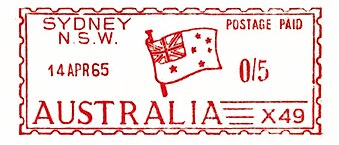


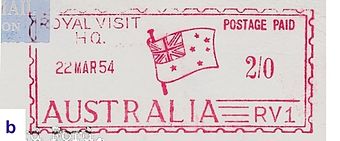
C1. Universal Postal Frankers “Multi-Value” (MV), 1953.
- Frank approximately 70 mm wide.
- Usually with "POSTAGE PAID", large or small, at top right, but also with ornaments in that spot.
- A. "POSTAGE PAID" in one line
- B. "POSTAGE" / "PAID" in two lines
- C. With “£ / s / d” or “£ | s | d” below "POSTAGE PAID"
- D. With a solid bar replacing POSTAGE PAID
- E. With three horizontal lines replacing POSTAGE PAID
- V/F (£sd): 0/0 —‘–0’—
- V/F (decimal): 0.oo =0.00
- a. Town line and license number boxed
- b. Inscribed "ROYAL VISIT / HQ.". Meters RV1 and RV2 used during the visit of Queen Elizabeth in 1954 [Very rare]

C2. Neopost "Frankmaster" / "305" (MV), 1965. [Scarce]
- Extra wide frank, approximately 83 mm wide.
- Simulated perforations in frame are square rather than semi-circular.
- Very wide design. One meter only, License number VJ3.
- V/F (£sd): =0/= =

C3. Neopost “205” (MV), 1965. [Scarce]
- Similar to Type C2 but much narrower design, only 55 mm wide.
- One meter only, License number VJ6.
- V/F (£sd):
 ’0 —
’0 — - V/F (decimal): 000
GROUP D: Straight-line frame containing large map of country
[edit | edit source]

D1. Pitney Bowes-GB “Automax” (MV), 1960.
- License number in box in upper left corner with airplane below.
- A. Airplane is almost horizontal, break in coastline near the plane
- B. Airplane aimed downward, coastline is complete near the plane
- TM: DC
- £sd V/F: =0/0 0/0= =0/0= =’–0’= =
- Decimal V/F: 0 00 0.00 =0.00
- a. Meter number unboxed
- b. Meter number vertical outside right frame line
- c. Meter number replacing map of Tasmania at bottom (12520)
- d. The plane is known altered and re-engraved on a few machines

D2. Pitney Bowes-GB “Automax” (MV).
- As Type D1 but Meter number and prefix vertical in panel at right.
- The Meter number can be stacked, reading up or reading down.
- Prefix “PB” or “A”, “PBA”, “AX” or nil.
- A. The box at upper left is blank
- B. The box at upper left is solid
- C. Without box at upper left
- TM: DC
- Decimal V/F: =0.00 0.00
- a. Meter number stacked outside frame line at right, not in panel
- b. With a number in place of the island of Tasmania at bottom
GROUP E: Frameless horizontal rectangle with pictorial design at left. Most of the rest of the frank consists of straight horizontal lines
[edit | edit source]Sub-group EA: Pictorial design is plane, country map, and surfer
[edit | edit source]

EA1. 1969, Pitney Bowes “Simplex” (LV-25), 1969.
- Frank nearly square.
- Wide spacing between TM and frank.
- Meter number with “PB”, “PBS” prefix or without prefix.
- TM: DC
- Values: .01 through .25
- a. With License number instead of Meter number


EA2. Pitney Bowes “5000”, “6200” (MV), 1965.
- Horizontal design.
- Meter number with “PB” or “PBF” prefix.
- A. With box around value figures
- B. Box around value figures open at right
- C. Without box around value figures
- TM: SC, DC
- V/F:
 0.00
0.00  00.00
00.00
- a. Error, with “PBE” prefix
- b. As A, without Meter number , printed in black, experimental Post Office use in 1993 [Uncommon]

EA3. Pitney Bowes “R” (MV), 1978.
- Similar to Type EA2 but smaller.
- With box around value figures.
- Meter number with “PB/R” prefix.
- TM: SC
- V/F: 0.00

EA4. Neopost "205" (MV). [Exceptionally rare]
- This stamp is known by a single example.
- The value figures are unboxed, and the meter number has no prefix.
- License number negative "88x" within solid bar.
- TM: SC with tall date figures
- V/F: 000
- a. With slogan in different color from the frank
Sub-group EB: Pictorial design is the Southern Cross star grouping
[edit | edit source]

EB1. Pitney Bowes “6300” (MV), 1972.
- "AUSTRALIA" at top, "POSTAGE PAID" at bottom.
- Meter number with “PB” prefix vertical at right reading up (normally) or down.
- TM: DC, SC
- V/F:
 0.00
0.00
- NOTE: If the town mark reads “CHRISTMAS ISLAND”, see Christmas Island.

EB2. Pitney Bowes “A/B900” (MV), 1988.
- Similar to Type EB1 but wider design.
- Meter number below Southern Cross.
- Meter number with “PBM” prefix left of "POSTAGE PAID".
- TM: DC, SC
- V/F:
 00.00
00.00

EB3. Pitney Bowes “6900” (MV), 1988.
- Similar to Type EB1 but taller.
- “PBB” or “PBE” prefix above the Meter number left of "POSTAGE PAID".
- TM: DC, SC
- V/F:
 0.00
0.00
- a. With slogan in different color from the frank
Sub-group EC: Pictorial design is a Koala bear
[edit | edit source]

EC1. Pitney Bowes “Paragon” (MV), 1995.
- Koala bear climbing branch in center.
- Without horizontal lines in frank.
- Meter number with “PBD” prefix.
- TM: SC
- V/F:
 00.00
00.00
- a. Without Meter number (Post Office use) [Uncommon]
GROUP F: Frameless frank nearly square with flowers at sides
[edit | edit source]

F1. Roneo Neopost "105" (LV-8/-10), 1969.
- Small frank with value at bottom. Meter number and POSTAGE PAID in center.
- Prefixes: “R”, “RV”, “VR”, “VE”, “N”, “VX”, “C/S”.
- Value figures with or without dot at left center.
- A. Narrow frank ~22-23 mm
- B. Wide frank ~27 mm wide
- TM: BIC
- Values (with or without leading stop): 03 through 10, 12, 13, 15, 18, 20 , 22, 24, 25
- a. POSTAGE PAID above Meter number rather than below it

F2. Roneo Neopost “105” (LV-10), 1969.
- As Type F1 but value in center, "POSTAGE PAID" and Meter number at bottom.
- Prefixes: “X”, “RNX”, “VX”, “RV”, “RNE”, “N”, “CS”, “C/S” or nil.
- A. Frank small, 25 x 24-25 mm
- B. Frank large, 29 x 28 mm [Uncommon]
- TM: DC
- Values: •01 through •25
- a. Value single digit, i.e. “6” rather than “06”
- b. Error, with “POST PAID” instead of “POSTAGE PAID” [Uncommon]


F3. Roneo Neopost “205/2205” (MV), 1969.
- Similar to Type F2 but multi-value and slightly larger frank.
- Prefixes: “V”, “VE”, “E”, “EG”, “C/S”, “CS”, or nil.
- A. Frank 24 mm square. Date figures tall ("205" model)
- B. Frank 25 mm square. Date figures short ("2205" model)
- TM: DC, BIC
- V/F: 0 00 0.00
NOTE: This type can have a slogan in a color different from the stamp

F4. Roneo Neopost "305" (MV), 1969.
- Similar to Type F3 but larger frank (like F2B), 29 x 28 mm, and wider spacing.
- Prefixes: “FME”, “F”, “VF”, “C/S”, “V”, “VE”.
- TM: DC
- V/F: ·00 0·00

F5. Roneo Neopost “505/405” (MV), 1969.
- Frank noticeably wider than tall, 32 x 25 mm.
- Prefixes: “B”, “VB”, “LB”.
- TM: BIC
- V/F: 00 000 0·00
 ·00 0000 00·00
·00 0000 00·00

- F6. 1983, Neopost “Electronic” (MV), 1983.
- Thick vertical bars mark the sides of the value box.
- Meter number with “EFM” prefix:
- EFM1xxxx Neopost EFM7/4300/4400
- EFM2xxxx Neopost 8500/8550
- EFM3xxxx Neopost 4450
- EFM4xxxx Neopost 5400/5450
- EFM5xxxx Neopost 7500/7550
- EFM6xxxx Neopost 7700/7750
- EFM80074 Neopost 7700/7750
- Note: Models ending ‘00’ are manual reset, while models ending ’50’ are Credipac.
- TM: DC, BIC
- V/F:
 0,00
0,00
GROUP G: Wide design with kangaroo and boomerang, with or without outer border
[edit | edit source]

G1. Roneo Neopost “105” (LV-8/-10), 1969.
- With single outer frame line enclosing the town mark and the frank.
- Value figures boxed. Prefixes: “X”, “C/S”.
- TM: DC, BIC, SC
- Values: 01 to 25 •01 to •25

G2. Roneo Neopost “105” (LV-10).
- As Type G1 but without outer frame.
- Value figures unboxed. Meter number with “X” prefix.
- TM: DC
- Values: 01 to 25 •01 to •25

G3. 1969, Postalia “PS3” (MV), 1969.
- Similar to Type G1 but taller and narrower frank.
- With outer frame line of various thickness, usually dashed.
- Value figures unboxed. Prefixes: “CS”, “C/S”, “ADS” or nil.
- A. With box around value figures
- B. Without box around value figures
- TM: DC
- V/F:
 .00
.00
- a. Outer frame lines at sides only, open at top and bottom
- b. With part of boomerang removed

G4. Postalia “PS3” (MV).
- As Type G3 but without outer frame line.
- Prefixes: "ADS", “CS”, “C/S”.
- TM: SC

G5. Postalia “PS4” (MV), 1983.
- Similar to Type G3 but the town mark is outside the outer frame line.
- Meter number with “PS” or nil prefix.
- TM: SC
- V/F: 0000 00.00
GROUP H: Square frank with simulated perforation outer border. Small sheep at top right
[edit | edit source]

H1. Satas “Baby” (MV), 1965.
- Simulated perforation border on all four sides of frank.
- "POSTAGE PAID" below "AUSTRALIA" at top.
- "SATAS" at bottom above Meter number .
- Column of wavy lines at left and right.
- TM: DC, SC
NOTE: This type can have a slogan in a color different from the stamp

H2. Satas “Baby” (MV).
- As Type H1 but with straight frame line and no wavy lines at right.
- Meter number 169701-169850
- TM: SC
- V/F: 00.00

- H3. Satas/Neopost “Electronic” (MV), 1985.
- Similar to Type H1 but with bars added at sides of value box.
- Meter number with “TAC” or “GBC” prefix:
- TAC0xxxx Satas Electronic (manual reset)
- TAC2xxxx Satas Electronic (Credipac)
- TAC3xxxx Satas SG700
- TAC4xxxx Satas SG750
- TAC5xxxx Satas SV500/SV550
- TAC6xxxx Satas SG800
- TAC7xxxx Satas SG850
- GBC7xxxx Neopost SM78
- GBC8xxxx Neopost SM84
- Note: Models ending ‘00’ are manual reset, while models ending ’50’ are Credipac.
- TM: DC
- V/F:
 0,00
0,00

H4. Satas/Neopost SM26” (digital), 1998.
- Similar to Type H3, but "AUSTRALIA", "POSTAGE PAID" and "SATAS" much thicker.
- TM and frank spaced very close together.
- Meter number with “GBC” prefix.
- TM: DC
- V/F:
 0.00
0.00
GROUP I: Horizontal rectangle with straight-line outer frame.
[edit | edit source]- AUSTRALIA in panel at top, Meter number and POSTAGE PAID in panels at bottom. Southern Cross star pattern at left

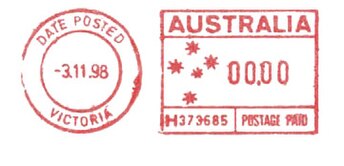
I1. Hasler “Mailmaster” (MV), 1983.
- Distance between centers of date and value figures is 37mm.
- Meter number with “H” prefix.
- A. The panel at bottom is divided unevenly, narrower at left, wider at right
- B. The panel at bottom is more or less evenly divided
- TM: DC, SC
- V/F: 00.00

I2. Ascom Hasler “Smile” (MV), 1997.
- Nearly identical to Type I1B but larger, with 40mm between centers of date and value figures.
- Meter number with “A” or "H" prefix.
- TM: DC
- V/F: 00.00
GROUP J: Square frank with herringbone pattern at sides
[edit | edit source]

J1. Neopost “2205” (MV), 1989.
- Meter number with “J” prefix.
- TM: BIC
- V/F: 0.00
GROUP K: Frank frame made up mostly of horizontal lines
[edit | edit source]

K1. Alcatel “9000” (MV), 1990.
- With "ALCATEL" above Meter number at bottom.
- Meter number with “GBC” or “EFM” prefix.
- TM: DC, SC, no outer rim, nil
- V/F
 0.00
0.00
GROUP L: Horizontal frameless frank with Koala bears on branch
[edit | edit source]

L1. Pitney Bowes “PostPerfect” (digital), 1995.
- With “PBX” prefix.
- TM: SL
- V/F $000.00
GROUP M: Designs containing a digital data matrix (2D barcode). Australia Post calls this design “FuturePost”.
[edit | edit source]Sub-group MA: Small data matrix below the value figures
[edit | edit source]

MA1. Pitney Bowes “PostPerfect” (digital), 1999.
- Frank frame 23 x 22 mm.
- Meter number with “P024” or “P043” prefix reading up between frank and TM.
- Two columns of numbers at left of TM.
- TM: SC
- V/F 00.00o

MA2. Pitney Bowes “Gem” (digital), 1999.
- Frank frame 29 x 20 mm. Meter number with “P01” prefix reading
- up in two columns between frank and TM.
- Two columns of numbers at left of TM.
- Printed with ink jet technology that leaves a horizontal
- linear texture to the value figures and other elements.
- TM: SC
- V/F 00.00o

MA3. Pitney Bowes “B900” (MV), 1999.
- Frank frame 27 x 23 mm.
- Data field breaks bottom frame line.
- Meter number with “P03” prefix reading up between frank and TM.
- TM: SC
- V/F
 0.00
0.00

MA4. Pitney Bowes “Paragon” (MV), 2000.
- Frank frame 30 mm square.
- Meter number with “P05” prefix reading up between frank and TM.
- TM: SC
- V/F 00.00

- a. Without meter number


MA5. Hasler “Smile” (MV), 1999.
- Frank frame 32 mm square.
- Meter number with "3011", "3026", "3086" or "3096" prefix reading up between frank and TM.
- A. : TM: SC reading AUSTRALIA at top and POSTAGE PAID at bottom
- B. : TM: DC reading DATE POSTED at top and town or state at bottom [Very rare]
- V/F 0.00 : 00.00 :
Sub-group MB: Large, square data matrix
[edit | edit source]

- POSTAGE PAID AUSTRALIA at bottom left.
- Impressions may include a service indicator, e.g. "PRIORITY", below the value and above the date.
NOTE: Inkjet versions of these stamps appear occasionally as half (top or bottom) impressions due to one inkjet malfunctioning". This variety can occur with most of the types listed.

MB1.1 Neopost “SM26” (digital), 1999.
- Meter number with “2060” or “2070” prefix vertical at right of data field.
- TM: SL
- V/F: 00.00o

MB1.2. Neopost “IJ25”, "IJ35", "IJ40" and "IJ45" (digital), 2001.
- As type MB1.1 but the value figures and town line are closer to the 2D data field.
- Meter number with “2040”, "2050", "8030" or "8040" prefix.
- TM: SL
- V/F: 00.00o

MB1.3. Neopost “IJ65”, "IJ70", "IJ80", "IJ90" and "IJ110" (digital), 2000.
- A. Data field with simulated perforation outer frame line with small break in the middle of each side
- B. Without the outer frame line
- Meter number with “2080” or "8090" prefix.
- TM: SL
- V/F: 00.00o 000.00o

MB2.1. Francotyp-Postalia “T1000” and "OptiMail" (digital), 2000.
- Data field as with Types MB1.1 and 1.2.
- Value figures heavier than on Types MB1 and 2.
- Meter number normally with “FT1” or "FT2" prefix, but a few machines were assigned "ET1" or "ET2" prefixes.
- TM: SL
- V/F: 00.00o

MB2.2. Francotyp-Postalia "UltiMail 45 / 65 / 65 / 95 / 120" (digital).
- Value figures and lettering tall and narrow, 11mm tall by 4mm wide.
- Meter number with "EU", "FU" or "MU" prefix, "-U4" for the 45, "-U6" for the 65, "-U9" for the 95 and the 120.
- V/F: 00.00o


MB2.3. Francotyp-Postalia "PostBase", "PostBase Mini" (digital).
- Very similar in appearance to MB2.2 but with six bank value figures.
- As shown in the image at right, the machine can print an extended slogan much wider than the stamp.
- A. PostBase model, Meter number with "MP6654" prefix
- B. PostBase Mini model, Meter number with "MM74754 prefix
- V/F: 000.00o

MB3. Frama (digital).
- Value figures narrow and medium in height, 9 mm tall.
- A. “EcoMail” model, Meter number with "1010" prefix
- B. “OfficeMail” model,. Meter number with "1110" prefix
- C. “MailMax” model, Meter number with "1220" prefix
- D. “Matrix” model, Meter number with "131" and "141" prefix
- V/F: 00.00o

MB4.1. Pitney Bowes “DM500”, "DM550", "DM800" and "DM900" (digital).
- Value figures 11 mm tall.
- Meter number with P1111 or "P1211" prefix.
- V/F: 00.00o

MB4.2. Pitney Bowes “DM100/100i” or "DM100 series Enhanced" (digital).
- As Type MB4.1 but Meter number with "P1715" or "P2551" prefix.
- V/F: 00.00o
- a. Printed in blue rather than red (P171503292 only)

NOTE: The area of Hutt River, population 23, seceded from Australia in 1970 and established The Principality of Hutt River. The Principality is not recognized by Australia or any other entity in the world. Although it issues its own stamps they are not valid anywhere and so the Hutt River Postal System must use Australian stamps to get anything mailed and delivered. Starting in 2016 they began using a postage meter with the slogan Royal Hutt River Postal System. The stamp from the meter is shown at right. Hutt River is one of several so-called rogue territories in Australia that despite their pretense to being independent states appear to exist only out of crankiness and to sell souvenirs.
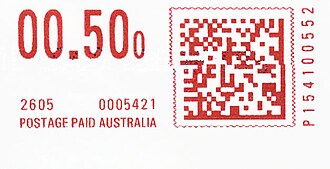
MB4.3. Pitney Bowes “DP100", "DP200" and "DP400" (digital).
- Simulated perforation frame around data field.
- Meter number with "P14" or "P15" prefix.
- V/F: 00.00o

MB4.4. Pitney Bowes “K700" (digital).
- As types MB4.1 and 4.2 but Meter number with "P1919" prefix.
- V/F: 00.00o

MB4.5. Pitney Bowes "DM300" (digital).
- Similar to Types MB4.1 and MB4.2 but Meter number with "P2331" prefix.
- V/F: 00.00o
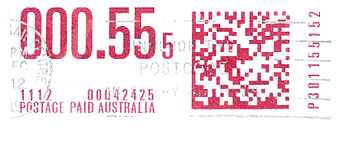
MB4.6. Pitney Bowes "Connect+" (digital).
- As Type MB4.5 but the meter number height is same as the data matrix height.
- Meter number with "P3011" prefix.
- This is the first meter with Group MB frank allowing stamps with postage value of $100 and above.
- The Connect+ model can print multi-colored slogans across the entire top of the envelope left of the frank.
- V/F: 000.00o
NOTE: A company called Officeworks produced and sold packets of ten envelopes prepaid with dateless stamps from meter P301155230. Denominations known at this time are 60 cents, $1.20 and $1.80.
Sub-group MC: Horizontal data matrix at lower left
[edit | edit source]

MC1. Neopost “IS” and "IX" series (digital), 2012.
- P POST logo inside solid bar above the value figures.
- Meter number at bottom right:
- with “8N1010” prefix (IS-350/420/440/480)
- with "8N1020" prefix (IS-280)
- with "8N1030" prefix (IS-6000)
- with "8N2050" prefix (IX-5)
- V/F: 000.00o
Sub-group MD: As Sub-group MB but 2D bar code matrix at left instead of right
[edit | edit source]

- MD1. Francotyp-Postalia “PostBase" and "Mini" (digital), 2018.
- As Type MB2.3 except for the reversal of the positions of the 2D bar code matrix and the text.
- Meter number between value and barcode.
- A. PostBase model with "MP" prefix
- B. Mini model with "MM" prefix
- V/F: 000.00o


- MD2. Pitney Bowes “SendPro-C" (digital), 2019.
- Similar to Type MD1 but the bar code matrix is smaller and the meter number is at far right.
- M# with "P2" prefix
- V/F: 000.00o
- A. Value and barcode closely spaced.
- B. Wider spacing between value and barcode, and with "PITNEY BOWES" running vertically between.
GROUP PO: Special stamps used only in Post Offices.
[edit | edit source]

- PO1. Ticket-Issue Machines (T.I.M.) (LV-12), 1951. [Very scarce]
- Stamps printed on gummed paper tape in red, purple or orange.
- With boxed “PARCEL POST” reading up at left or at right.
- Frank size (not including PARCEL POST box) 52 x 31 mm.
- TM open at sides, value box with single straight line frame.
- Used at "RUSSELL STREET" and "RICHMOND, VICTORIA".
- Values seen: 1d, 6d, 1/-, 1/4, 1/5, 1/8, 1/10, 2/3, 2/6, 2/11, 3/9, 5/-, 5/5, 5/11

- PO2. T.I.M. (LV-12), 1953. [Very scarce]
- Similar to Type PO1 but smaller, 46 x 22 mm.
- TM closed at sides. Value box open at top and bottom.
- Used at "CLARENCE ST, N.S.W." and "HAYMARKET, N.S.W.".
- Values seen: 1d, 6d, 1/-, 1/4, 1/5, 1/8, 1/10, 2/3, 2/6, 3/-, 3/9, 5/-, 5/5, 5/6, 5/11

- PO3. NCR (MV), 1957.
- Stamp printed in red, orange, purple, brown or yellow on plain white tape.
- Inscription in two groups: post office name and “POSTAGE PAID” in center, date and value figures at bottom.
- “POSTAGE PAID” above or below Post Office name.
- £sd V/F: 0•0•0
- Decimal V/F: 0•00 00•00


- PO4. NCR (MV), at least 1968.
- Similar to Type PO3 but inscription in four groups:
- A. From top to bottom: “POSTAGE PAID”/ date/ S# and value figures/ "POSTAGE PAID” and post office ID
- B. As A, but without “POSTAGE PAID” at top
- C. From top to bottom: Post Office ID/ date / S# and postage/ "POSTAGE PAID"
- D. As C, but with dotted lines at bottom instead of "POSTAGE PAID"
- V/F: $oo00.00-


- PO5. Heugin “KA4511” (MV), 1975.
- Printed in orange, pink-red or purple on white tape wider than tall.
- A. Post office name at top above state, country and post code, with “POSTAGE PAID” on third line.
- B. "POSTAGE PAID" at top above post office name, with city and post code on third line.
- Value figures and date at bottom, with year figures vertical.
- V/F: $00.00


- PO7. Hytech Aust “Postal Charges Calculator” (MV), 1984. [Scarce]
- Printed by ink-jet in purple on white tape.
- “POSTAGE PAID” above “AUSTRALIA” at top, followed by ID number
- and date, two lines of numbers, and the value at the bottom.
- Printed in purple.
- V/F: $0•00
- a. Used on tape with underprint

- PO8. Hytech Aust “Postal Charges Calculator Mark 1” (digital), 1985.
- Similar to Type PO7 but “POSTAGE PAID/ AUSTRALIA POST” at top,
- followed by ID number and date, 7-digit number, and the value figures at the bottom.
- Printed on tape with full underprint design or underprint at sides only.
- Printed in purple or black.
- V/F: $$$$0•00
- a. Printed on plain white tape [Uncommon]

- PO9. Hytech Aust “Postal Charges Calculator Mark 2” (digital), 1988.
- “POSTAGE PAID/AUSTRALIA” underlined at top, followed by post office name
- and number, machine ID, time and date, with value at bottom.
- Tape with underprint design only along sides.
- V/F: $$$$0•00
- a. Printed on plain white tape [Uncommon]
- b. Printed on tape with full underprint
- NOTE: The receipts look like the stamps but read “AUSTRALIA POST/THANK YOU” at top.

- PO10. Hytech “Combined Scale Calculator” (digital), 1990.
- “AUSTRALIA”/ value figures/ “POSTAGE PAID” at the top with brackets at the sides.
- Printed on white tape with underprint design at sides.
- Underprint in mauve or gray. Stamp in gray/black or purple.
- Bottom line text as follows: date, time, weight.
- V/F: $0.00

- PO10.1. Hytech “Combined Scale Calculator” (digital).
- As Type PO10 but the town name appears between "AUSTRALIA" and the value figures.
- The text in the bottom line is different from PO10: date, time, post code, and 6-digit number.
- Printed on paper without underprint.
- V/F: $0.00

- PO11. Hytech “Combined Scale Calculator” (digital). [Uncommon]
- As Type PO10 but with koala bear and kangaroo replacing the brackets.
- V/F: $0.00

- PO12. Electronic Point of Sale (EPOS) “A” (digital), 1991. [Uncommon]
- Dotted bars at top and bottom of stamp. “AUSTRALIA” underlined
- below top bar, “Postage Paid” above bottom bar. Postage value in red.
- Printed by ink-jet on white tape with underprint design at sides.
- V/F: $0.00 (red)
- a. Value in black [Very scarce]

- PO13. EPOS “Ezipost” (digital), 1992.
- Similar to Type PO12 but with dashed lines instead of dotted bars at top and bottom.
- “AUSTRALIA” not underlined. Value in gray-black instead of red.
- Printed on tape with overall underprint in gray or pink or with underprint at the sides only.
- A. “From” and post code below value figures
- B. Weight and “to” destination country below value figures.
- V/F: $0.00 $00.00
- a. In purple instead of gray-black [Scarce]
- b. With “GST Free” above value figures

- PO14. “Postal Services Unit” (digital), 1995.
- With dotted line at top and bottom as with Type PO13 but the top line has a 6-digit number at right.
- Sequence of inscriptions between the dotted lines:
- “POSTAGE PAID”/ post office name / “AUSTRALIA”/ value figures/ date, time, machine ID, transaction ID
- V/F: 00¢ $00.00
- NOTE: For this stamp with “CHRISTMAS ISLAND” above “AUSTRALIA”, see CHRISTMAS ISLAND.


- PO15. EPOS (digital), 2008.
- Unframed stamp on plain, white self-adhesive label with rounded corners.
- Sequence of inscriptions from top: "AUSTRALIA" / post office name / value figures / weight and destination / machine ID, time, 4-digit postal code, single number code of uncertain meaning, and transaction ID / "Postage Paid"
- A. Country name with or without mail class alone at top
- B. With image of hand holding a stylus added at top center (2013)
- V/F: $0.00 $00.00
- a. With bar code at left. Two types:
- * Until June 2011, a generic barcode possibly identifying the origin or destination (shown)
- * After June 2011, a tracking or registration barcode
- b. Stamp generated at philatelic or public event showing name of the temporary show post office
- c. "Additional Paid" rather than "Postage Paid"
- a. With bar code at left. Two types:
- NOTES:
- On some stamps the weight can show as "xxxx". Also on some stamps an extra line line of text identifying extra services can be found. Known: Optional Extras, Express Post, Priority Letter
- The stamp normally does not have a barcode. Shown is a stamp for registered mail that includes a barcode.
- Although generated by a machine at the Post Office counter this stamp is nearly identical to stamps generated by self-serve kiosks within post offices. The differences between the stamps are very slight.
- NOTES:

- PO16. EPOS (digital).
- One stamp seen appearing as a registration label except that it includes "This is not a receipt" and a postage value.
- The two lines of text below "This is not a receipt" (at center) are as follows:
- "SAT" (for satchel), weight, value figures
- 13-digit code (tracking number / counter position / cumulative transaction number)
- The country of origin is identified only in the value figure prefix of "AU".
- machine ID, time and transaction ID/ "Postage Paid".
- This stamp was used only on prepaid stationery sent overseas.
- V/F: AU$00.00
- NOTE: The stamp is reported to fade quickly.


- PO17.1. EPOS (digital), 2013.
- As Type PO15 but with replacement printer.
- The text font is taller, and the arrangement of elements is slightly different.
- A. With tracking or registration barcode at left
- B. With square 2D barcode
- C. Without barcode, blank on left side of label
- V/F: $0.00 $00.00
- a. Used in Norfolk Island
- b. Without post office name below "AUSTRALIA" [appears to be rare]



- PO17.2. EPOS (digital).
- As Type PO17.1 but the value figures are thicker and wider.
- A. With tracking or registration barcode at left
- B. With square 2D barcode
- C. Without barcode, blank on left side of label
- D. Express Post stamp (This is the first digital PO meter stamp available for this service.)
- V/F: $0.00 $00.00
- a. With tracking number above the barcode (A, B, or D) and the article number below
- a. With tracking number above the barcode (A, B, or D) and the article number below


- PO18. EPOS (digital), 2016.
- As Types PO15 and PO17 but the printing is of higher resolution with smooth diagonals to the letters and numbers.
- The value figures are repositioned lower on the stamp, just above "Postage Paid" at the bottom.
- A. With tracking or registration barcode at left
- B. Without barcode
- V/F: $0.00 $00.00
GROUP X: Early experimental stamps
[edit | edit source]
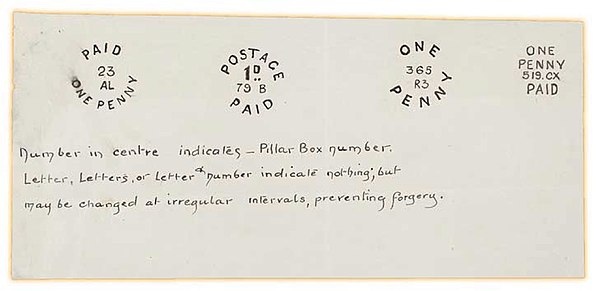
X1. W. Hollingworth, May 1903.
- Mr. Hollingworth invented a public coin-in-the slot stamp franking machine that was trialed in the Brisbane GPO from 8 May to 6 June 1903.
- No examples of the stamp are known to exist. Shown is an image of a sheet that Hollingworth submitted to postal authorities during his negotiations with the Post Office Department. The actual stamp may be similar to one of the four ink-drawn designs on the sheet.
- Value: 1d


X2. "Mr. Gray", November 1904.
- The Tasmanian Patent Purchase Association proposed a public coin-in-the slot stamp franking machine that was developed by a "Mr. Gray." Three different tests of the machine were made at the Hobart GPO as follows: 9-12 November 1904, 23 November to 8 December 1904, and 30 March to 3 April 1905. During the three tests approximately 500 to 600 articles of mail were franked.
- Shown at left is an image of a proof in postal archives. Shown at right is a scan of a poor photocopy of an image of the stamp that appeared in a Premier Philatelic Auction catalog in 2001. This is the only known postally used Group X stamp to have survived.
- Value: 1d
X3. John Husband's "Automatic Letter and Newspaper Franker, November 1904.
- Over the course of one and a half days, from 23 to 24 November 1904, a public coin-in-the slot stamp franking machine invented by Mr. Husband was trialed at the Melbourne GPO. No stamp, proof, or drawing of the stamp is known.

X4. J.A. Brown, December 1905.
- From an unknown date in December 1905 to 10 January 1906 a public coin-in-the slot stamp franking machine invented by Mr. J.A. Brown was trialed at the Brisbane GPO. The only surving examples of the stamp are from a sheet with four proof impressions in the Australia Post archival collection.
- Value: 1d
X5. Russell, Young and Butler, October 1906.
- Starting on an unknown date in October 1906 and concluding after a "short period of use" a public coin-in-the slot stamp franking machine invented by Mr.'s Russell, Young and Butler was trialed at the Hobart GPO. No stamp, proof, or drawing of the stamp is known.
X6. Automatic Franking Machine Company "Model C" (Ernest Moss) of New Zealand, June 1908.
- A meter design being used successfully in New Zealand was trialed in the Australia Department of External Affairs in Melbourne starting on 15 June 1908. The trial lasted one month and ended probably on 15 July 1908. This machine was capable of printing five different postage values. Although the trial was successful with the Department praising the machine, it was not approved for further use due to a legal technicality.
- Although possibly hundreds of covers were franked by the machine during the trial no examples are known to exist and no examples have been located in postal archives. The stamps probably are similar in appearance to New Zealand Type A9.
- Values: ½d, 1d, 2d, 6d, 1/-

X7.1. R.J. Price and H.A. Breswicke, 26 May 1908.
- Mr.'s Price and Breswicke's public coin-in-the slot stamp franking machine was trialed at the Melbourne GPO on 26 May 1908. Possibly as many as a thousand pieces of mail were franked by the machine over the course of the day. The test was not continued on the next day possibly due to technical problems.
- No examples of the stamp are known to exist. Shown is a drawing of the stamp along with a drawing of the machine itself.
- Value: 1d
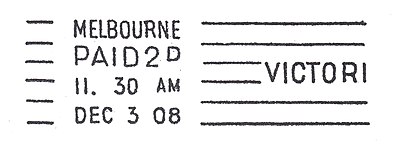
X7.2. R.J. Price and H.A. Breswicke, December 1908.
- In early December 1908 an improved version of the Price and Breswicke machine was trialed for "a short period". The stamp was completely different. Replacing the circlular design the new frank resembles a machine postmark. It consists of four lines of unframed text (MELBOURNE / PAID 2D / time / date) with horizontal bars at the sides, short at left and long at right with "VICTORIA" imbedded in the lines at right. As with the first trial this one probably lasted only a matter of hours. No actual examples of the frank are known to exist.
- Value: 2d

X8. Automatic Franking Machine Company "Model D" (Ernest Moss) of New Zealand, 1920.
- A meter from Moss's firm (see Type X6) was trialed again in 1920, this time in the Bulk Postage section of the Melbourne GPO.
- The exact dates of the test are not known nor are the number of stamp impressions generated during the trial. The scan is of a proof strip from Moss's company's archives.
- Values: ½d, 1d, 1½d, 6d, 1/-



















